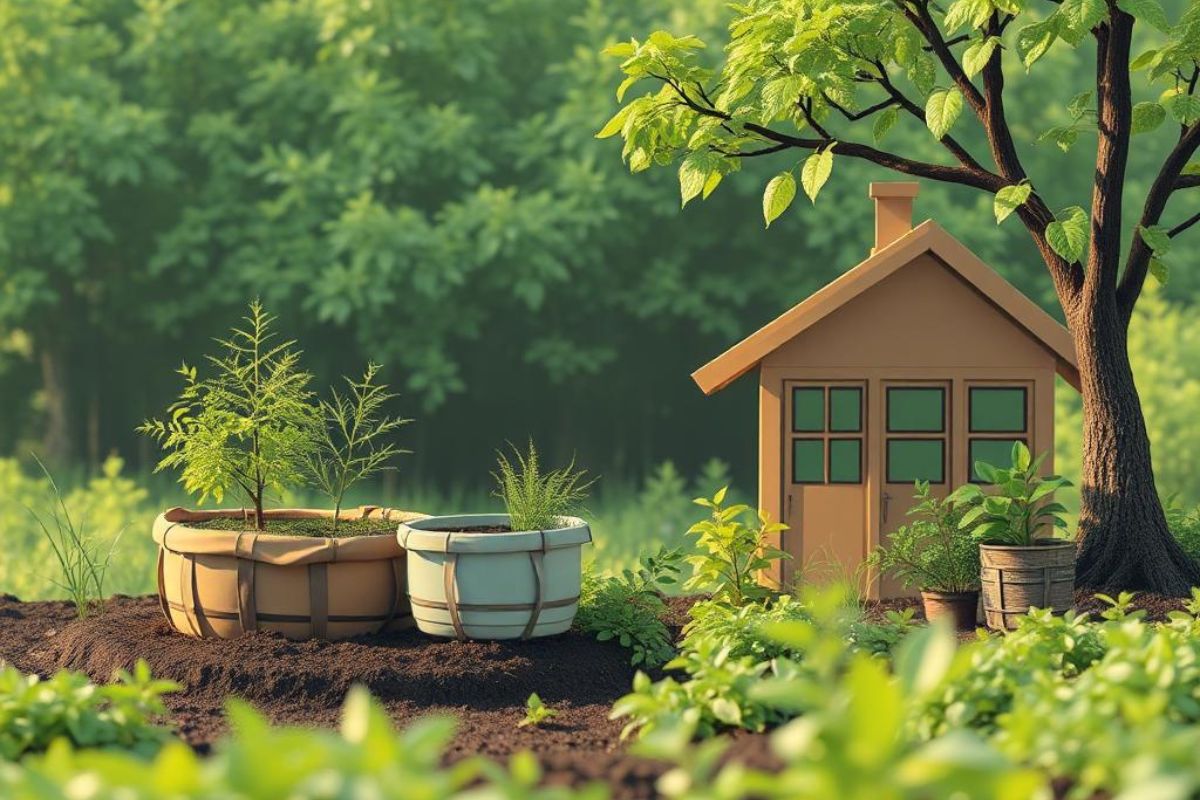Sustainable living can feel overwhelming, especially when outdoor maintenance adds to the load. Keeping a yard eco-friendly and manageable doesn't have to be an uphill battle. Small changes in landscaping, technology use, and plant choices make it easier.
Think about your goals: lower water usage, less labor-intensive upkeep, or more native greenery. Practical steps ensure balance without endless hours outdoors.
Ready for actionable advice? These simple methods help create sustainable spaces with minimal effort. It’s easier than you think - let's explore!
1. Choose Native Plants for Easy Growth
Native plants are a game-changer for sustainable living. They thrive in local climates, needing less water, fertilizer, and attention. By planting them in your yard, you not only minimize upkeep but also support biodiversity by attracting essential pollinators like bees and butterflies.
Local gardening centers or native plant societies often provide great options for beginners. For instance, goldenrod or milkweed are excellent choices in temperate zones of the U.S., while succulents like agave work beautifully in arid regions.
Unlike exotic species that demand extra care to adapt, natives align with their environment naturally. This means fewer resources spent on watering and fertilizing year-round. Once established, these plants flourish with minimal input from you - leaving more time to enjoy your green space.
Choosing native greenery keeps maintenance low while contributing positively to the environment around you! Perfect balance!
2. Adopt Xeriscaping for Water Conservation
Xeriscaping, the practice of creating landscapes that minimize water usage, presents an efficient approach to keeping a verdant space with little exertion. Utilizing drought-tolerant flora and smart planning, you conserve resources and shrink your ecological impact.
Key principles of xeriscaping include:
- Group plants by water needs: This simplifies irrigation and prevents overwatering.
- Replace lawns with hardy alternatives: Use gravel, mulch, or native ground covers instead of grass.
- Choose drought-tolerant species: Succulents like sedum or decorative grasses require little hydration but look stunning year-round.
- Install drip irrigation systems: These deliver precise watering directly to roots without wasteful runoff.
Xeriscaping isn’t just for desert regions; it’s adaptable everywhere! Once established, these landscapes demand less care while naturally conserving resources - perfect for sustainable outdoor living without endless upkeep demands.

3. Leverage Technology for Streamlined Maintenance Tasks
Innovative smart technology streamlines the task of cultivating an eco-friendly garden. Devices such as programmable sprinklers and sensors for irrigation supply precise water amounts to plants, eliminating waste and guesswork. This not only saves water but also eliminates the guesswork of manual watering schedules.
When it comes to simplifying lawn care, integrating digital tools makes a difference. Lawn care management software, for example, can automate essential tasks such as scheduling maintenance or tracking seasonal needs for your outdoor space.
Platforms like Briostack offer automated solutions that align perfectly with eco-conscious practices while ensuring consistent upkeep.
With these innovations in place, you spend less time on routine chores and more enjoying your yard’s natural beauty. Letting technology handle repetitive jobs means easier maintenance without compromising sustainability - a win-win for both convenience and the environment!
4. Install Drip Irrigation for Targeted Hydration
Drip irrigation stands out as a resource-conserving solution for watering plants. This method surpasses conventional sprinklers by channeling water right to the plant roots, guaranteeing immediate and targeted hydration. This reduces waste from evaporation and runoff, especially in hot or dry climates.
Installing a drip system is easier than it seems. Kits are widely available and often include tubing, emitters, and connectors you can customize to fit your garden layout. You’ll use significantly less water compared to overhead watering methods.
The consistent moisture also promotes healthier plant roots with the minimal manual effort required from you once set up.
Whether you're growing flowers or vegetables - or even maintaining xeriscaped landscapes - this technology optimizes care without wasting time or energy on inefficient watering habits. A practical step towards sustainable living with manageable upkeep!

5. Opt for Ground Covers or Mulch Over Grass
Conventional grass turfs often require extensive water and effort. Substituting grass with easy-care ground covers or mulching alternatives presents a sustainable strategy that conserves both time and resources.
Consider these alternatives:
- Creeping Thyme: A fragrant, flowering option perfect for sunny areas.
- Clover: Stays green longer than grass, requires less mowing, and naturally enriches the soil.
- Sedum (Stonecrop): Hardy and drought-resistant, ideal for xeriscaping designs.
Mulching offers another practical choice if you prefer minimal planting. Employing organic materials like wood chips or bark can maintain soil moisture, curb weed growth, and gradually break down to enrich the garden. For those in warmer climates, selecting the right mulch is essential for protecting plants from heat and drought. If you're looking for high-quality mulch in California, choosing a reliable supplier ensures your garden gets the best materials suited for the region's climate.
Implementing these adjustments lessens overall maintenance and negates the demand for frequent watering or heavy fertilizing associated with conventional grass lawns - streamlining garden care and enhancing its eco-friendliness!
6. Implement Intelligent Composting Methods for Enhanced Soil Vitality
The art of composting converts garden refuse and kitchen leftovers into a fertile medium ideal for eco-conscious horticulture. Through the repurposing of organic detritus, such as foliage, lawn snippets, or food rinds, your garden thrives without dependence on synthetic enhancers.
This cycle fosters robust plant growth and mitigates the mass of waste destined for landfills. For a low-maintenance approach, consider a compost tumbler or vermicomposting with worms. Both methods speed up decomposition while containing mess and odors effectively.
Place your compost setup in a shaded corner of the yard to avoid disrupting outdoor activities. Add browns (like dry leaves) and greens (vegetable scraps) in balance for the best results.
Over time, this “black gold” feeds plant roots naturally without excessive effort from you - a self-sustaining cycle that aligns perfectly with minimal maintenance goals while improving your garden's overall vitality!

7. Utilize Perennials for Lasting Elegance with Minimal Replanting
Perennials serve as the cornerstone of an effortless, sustainable garden design. These steadfast plants reemerge annually, obviating the necessity for frequent replanting or periodic garden renewals. By choosing perennials suited to your climate, you save time while creating a vibrant and enduring outdoor space.
Options like black-eyed Susans, lavender, or hostas bring lasting color and texture without requiring much care once established. They often need less water and fertilizer compared to annuals since their deep root systems help them thrive naturally in varying conditions.
Spacing out plantings reduces crowding while giving perennials room to grow robustly over seasons. Combined with native selections or xeriscaping methods, these choices enhance biodiversity without demanding extra work from you each spring. This simple shift leads to beautiful greenery that keeps maintenance stress off your shoulders!
8. Create Functional Outdoor Spaces That Need Minimal Care
Designing functional outdoor spaces can reduce upkeep while increasing usability. By focusing on practical, low-maintenance elements, you create a yard that works for your lifestyle without constant effort.
Here are some ideas to consider:
- Hardscaping Features: Patios, stone walkways, or gravel paths replace grass areas and eliminate mowing.
- Multi-purpose Furniture: Weather-resistant seating doubles as storage for gardening tools or cushions.
- Native Shrubs or Hedges: These provide natural privacy barriers with minimal trimming needs.
- Potted Plants on Decks/Patios: Use pots to keep plants organized and easily movable if needed.
These choices focus on simplicity without sacrificing aesthetics or functionality. With intentional planning and resourceful design decisions like these, your yard becomes more enjoyable and far easier to maintain - perfect for sustainable living with less outdoor work!
Sustainability Starts with Small, Intentional Steps
Sustainability doesn’t require a complete overhaul. Small, intentional changes make a big difference in reducing maintenance and environmental impact. Whether you’re swapping grass for ground covers or installing drip irrigation, each step builds toward an eco-friendly outdoor space that works with your lifestyle.
Focus on balance - simplify upkeep without sacrificing beauty or functionality. Sustainable choices not only save time but also contribute positively to the environment around you. Start small today, and watch your low-maintenance yard thrive over time!






Share: